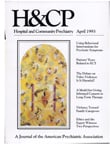Hospital Characteristics, Diagnoses, and Staff Reasons Associated With Use of Seclusion and Restraint
Abstract
Objective: Patterns of seclusion and restraint over a one-year period at 82 Veterans Affairs medical centers were examined to determine whether use of these interventions was influenced by hospital characteristics (such as geographic location, per diem cost, patient-staff ratio, and university affiliation), patient diagnoses, or reasons for use. Methods: For comparison, medical centers were grouped into seven geographic regions and into three frequency-of-use groups. Mean use rates and hospital characteristics were examined by rank correlational analysis. Results: Among hospital characteristics, only geographic location was associated with differences in use of seclusion and restraint. Mean rates of use in the Pacific and Mid-Atlantic regions were significantly lower than those in other regions. Total hours of seclusion and restraint at the 20 highest-use centers differed from those at the 20 lowest-use centers by a factor of ten. Patients with schizophrenic disorders were secluded or restrained most frequently. Centers with the highest rates used these interventions most frequently for reasons not associated with violent or potentially violent behaviors. Conclusions: The large geographic variations in use of seclusion and restraint may be a function of different standards of practice or of different state laws.
Access content
To read the fulltext, please use one of the options below to sign in or purchase access.- Personal login
- Institutional Login
- Sign in via OpenAthens
- Register for access
-
Please login/register if you wish to pair your device and check access availability.
Not a subscriber?
PsychiatryOnline subscription options offer access to the DSM-5 library, books, journals, CME, and patient resources. This all-in-one virtual library provides psychiatrists and mental health professionals with key resources for diagnosis, treatment, research, and professional development.
Need more help? PsychiatryOnline Customer Service may be reached by emailing [email protected] or by calling 800-368-5777 (in the U.S.) or 703-907-7322 (outside the U.S.).



